MBA Project: Analysis of Indo-Western Brands Expansion Challenges
VerifiedAdded on 2023/04/20
|31
|8699
|179
Project
AI Summary
This MBA project investigates the factors impacting the success of Indo-Western brands expanding into Western markets. It begins with an introduction to the global apparel industry and the challenges faced by Indian brands, including cultural differences and marketing strategies. The research explores the philosophical position, aims, and objectives of the study, followed by a comprehensive literature review of the fashion industry's current state and the challenges faced by Indian brands in foreign markets. The methodology section details the research philosophy, design, strategy, and data analysis techniques employed. Key findings are presented from questionnaires and focus group discussions, comparing them with the literature review. The project concludes with a summary of findings and recommendations for Indo-Western brands aiming to expand internationally, offering insights into market expansion strategies and ways to navigate the challenges in the Western market. The project also includes an overview of the Indian fashion industry and the challenges that they face when expanding internationally.
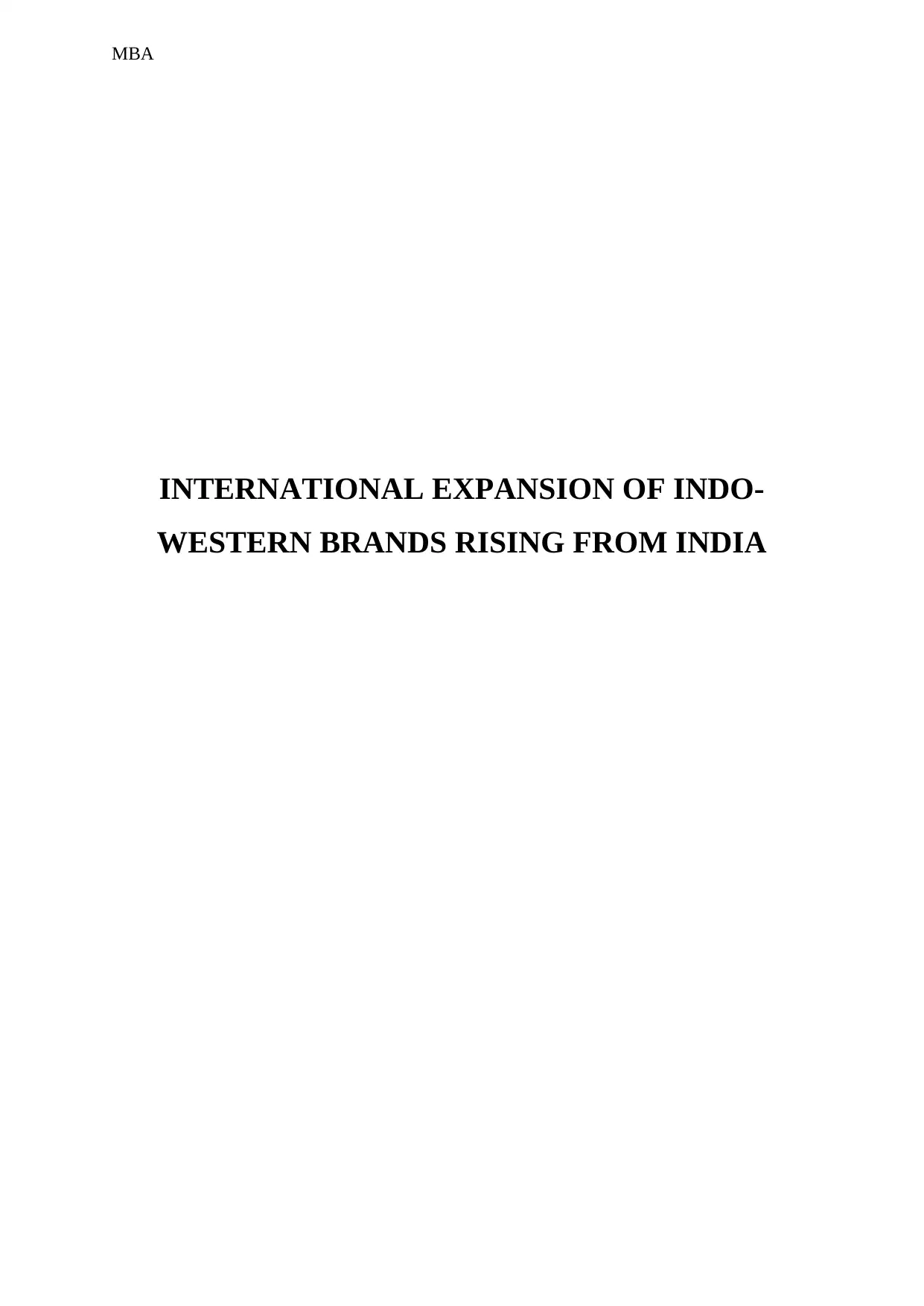
MBA
INTERNATIONAL EXPANSION OF INDO-
WESTERN BRANDS RISING FROM INDIA
INTERNATIONAL EXPANSION OF INDO-
WESTERN BRANDS RISING FROM INDIA
Paraphrase This Document
Need a fresh take? Get an instant paraphrase of this document with our AI Paraphraser
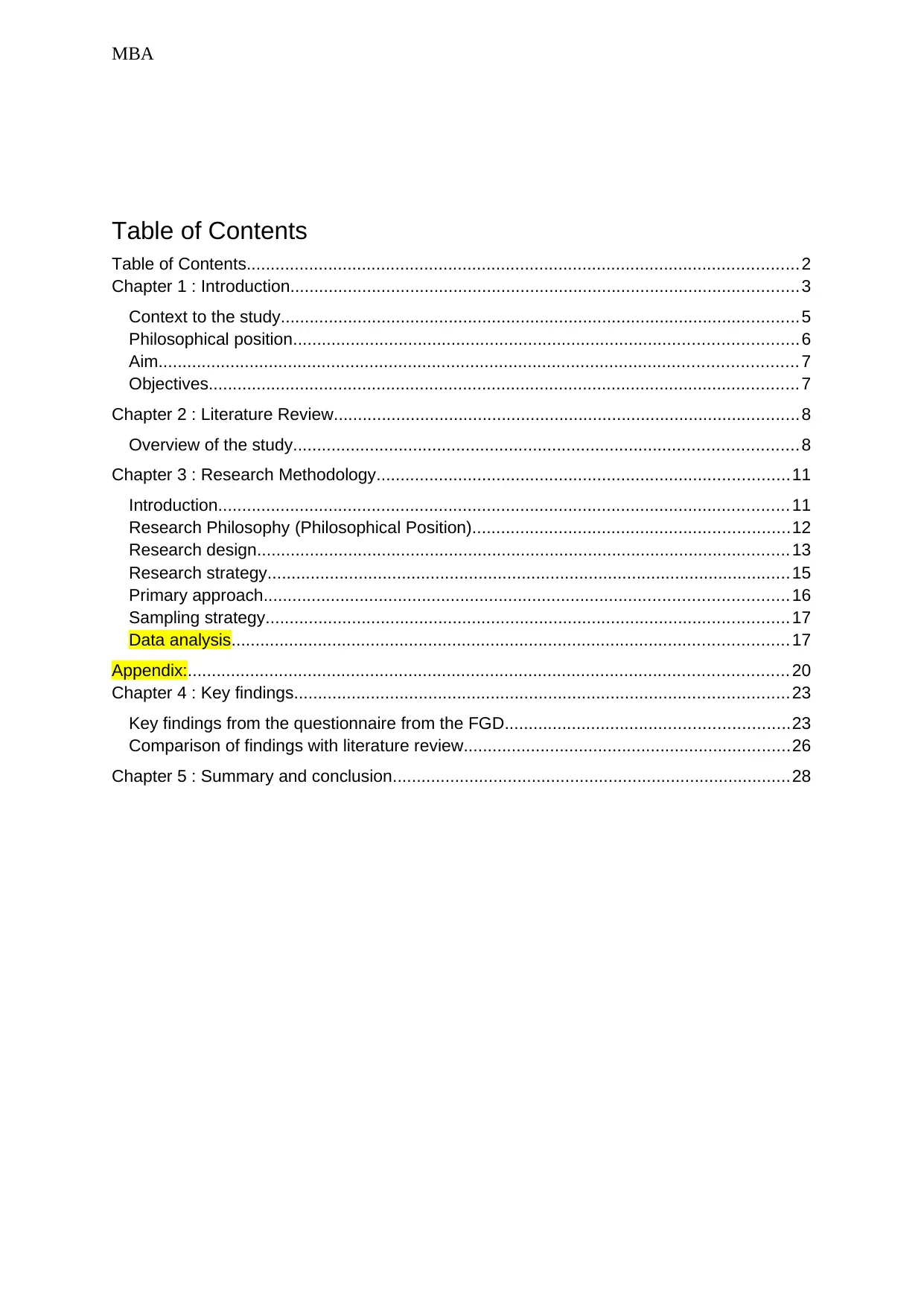
MBA
Table of Contents
Table of Contents...................................................................................................................2
Chapter 1 : Introduction..........................................................................................................3
Context to the study............................................................................................................5
Philosophical position.........................................................................................................6
Aim..................................................................................................................................... 7
Objectives........................................................................................................................... 7
Chapter 2 : Literature Review.................................................................................................8
Overview of the study.........................................................................................................8
Chapter 3 : Research Methodology......................................................................................11
Introduction....................................................................................................................... 11
Research Philosophy (Philosophical Position)..................................................................12
Research design............................................................................................................... 13
Research strategy............................................................................................................. 15
Primary approach............................................................................................................. 16
Sampling strategy............................................................................................................. 17
Data analysis.................................................................................................................... 17
Appendix:............................................................................................................................. 20
Chapter 4 : Key findings.......................................................................................................23
Key findings from the questionnaire from the FGD...........................................................23
Comparison of findings with literature review....................................................................26
Chapter 5 : Summary and conclusion...................................................................................28
Table of Contents
Table of Contents...................................................................................................................2
Chapter 1 : Introduction..........................................................................................................3
Context to the study............................................................................................................5
Philosophical position.........................................................................................................6
Aim..................................................................................................................................... 7
Objectives........................................................................................................................... 7
Chapter 2 : Literature Review.................................................................................................8
Overview of the study.........................................................................................................8
Chapter 3 : Research Methodology......................................................................................11
Introduction....................................................................................................................... 11
Research Philosophy (Philosophical Position)..................................................................12
Research design............................................................................................................... 13
Research strategy............................................................................................................. 15
Primary approach............................................................................................................. 16
Sampling strategy............................................................................................................. 17
Data analysis.................................................................................................................... 17
Appendix:............................................................................................................................. 20
Chapter 4 : Key findings.......................................................................................................23
Key findings from the questionnaire from the FGD...........................................................23
Comparison of findings with literature review....................................................................26
Chapter 5 : Summary and conclusion...................................................................................28

MBA
Chapter 1 : Introduction
This research evaluates the factors that affect the success of Indo-western brands expanding
into the West. According to a report by Keller et al. (2014), the global apparel industry is
growing rapidly while at the same time evolving due to a number of factors including
changing demographics, effect of social media, global wealth distribution, customer
expectations, and technological advancements. It goes on to state that for brands to succeed,
they need to be agile and be able to rapidly adapt the business model to make the most of
evolving markets while letting go of traditional practices.
East Asian brands have started to expand to foreign markets with the aim of providing a
variety of both traditional and fusion fashion to their international consumers. However, in
spite of a noticeable growth, Indian brands have faced issues such as cultural problems, lack
of pricing strategies, etc. This research has tried to show the issues which are faced by Indian
designers (with the main focus on Indo-Western brands) while trying to expand their business
to Western countries.
Indo-western brands have been trying to expand into the west for quite some time now,
however their efforts have not borne much meaningful fruits (Aaker & McLoughlin, 2010).
There are various reasons behind this and there are many challenges that the Indo-western
brands actually face in their aim to make an entry in western markets. This particular research
is going to discuss the topic of why Indo-western brands have not been in a position to
successfully expand to the west, and in doing so certain aspects about Indo-western brands
and designs and some market expansion strategies will be looked at. Due to various factors
such as changes in technology among others, we’ve seen that the Indo-western brands and
designs have been evolving. Fashion has taken a completely different turn and things are not
the way they used to be a decade ago. Indo-western brands have done well in various areas
Chapter 1 : Introduction
This research evaluates the factors that affect the success of Indo-western brands expanding
into the West. According to a report by Keller et al. (2014), the global apparel industry is
growing rapidly while at the same time evolving due to a number of factors including
changing demographics, effect of social media, global wealth distribution, customer
expectations, and technological advancements. It goes on to state that for brands to succeed,
they need to be agile and be able to rapidly adapt the business model to make the most of
evolving markets while letting go of traditional practices.
East Asian brands have started to expand to foreign markets with the aim of providing a
variety of both traditional and fusion fashion to their international consumers. However, in
spite of a noticeable growth, Indian brands have faced issues such as cultural problems, lack
of pricing strategies, etc. This research has tried to show the issues which are faced by Indian
designers (with the main focus on Indo-Western brands) while trying to expand their business
to Western countries.
Indo-western brands have been trying to expand into the west for quite some time now,
however their efforts have not borne much meaningful fruits (Aaker & McLoughlin, 2010).
There are various reasons behind this and there are many challenges that the Indo-western
brands actually face in their aim to make an entry in western markets. This particular research
is going to discuss the topic of why Indo-western brands have not been in a position to
successfully expand to the west, and in doing so certain aspects about Indo-western brands
and designs and some market expansion strategies will be looked at. Due to various factors
such as changes in technology among others, we’ve seen that the Indo-western brands and
designs have been evolving. Fashion has taken a completely different turn and things are not
the way they used to be a decade ago. Indo-western brands have done well in various areas
⊘ This is a preview!⊘
Do you want full access?
Subscribe today to unlock all pages.

Trusted by 1+ million students worldwide
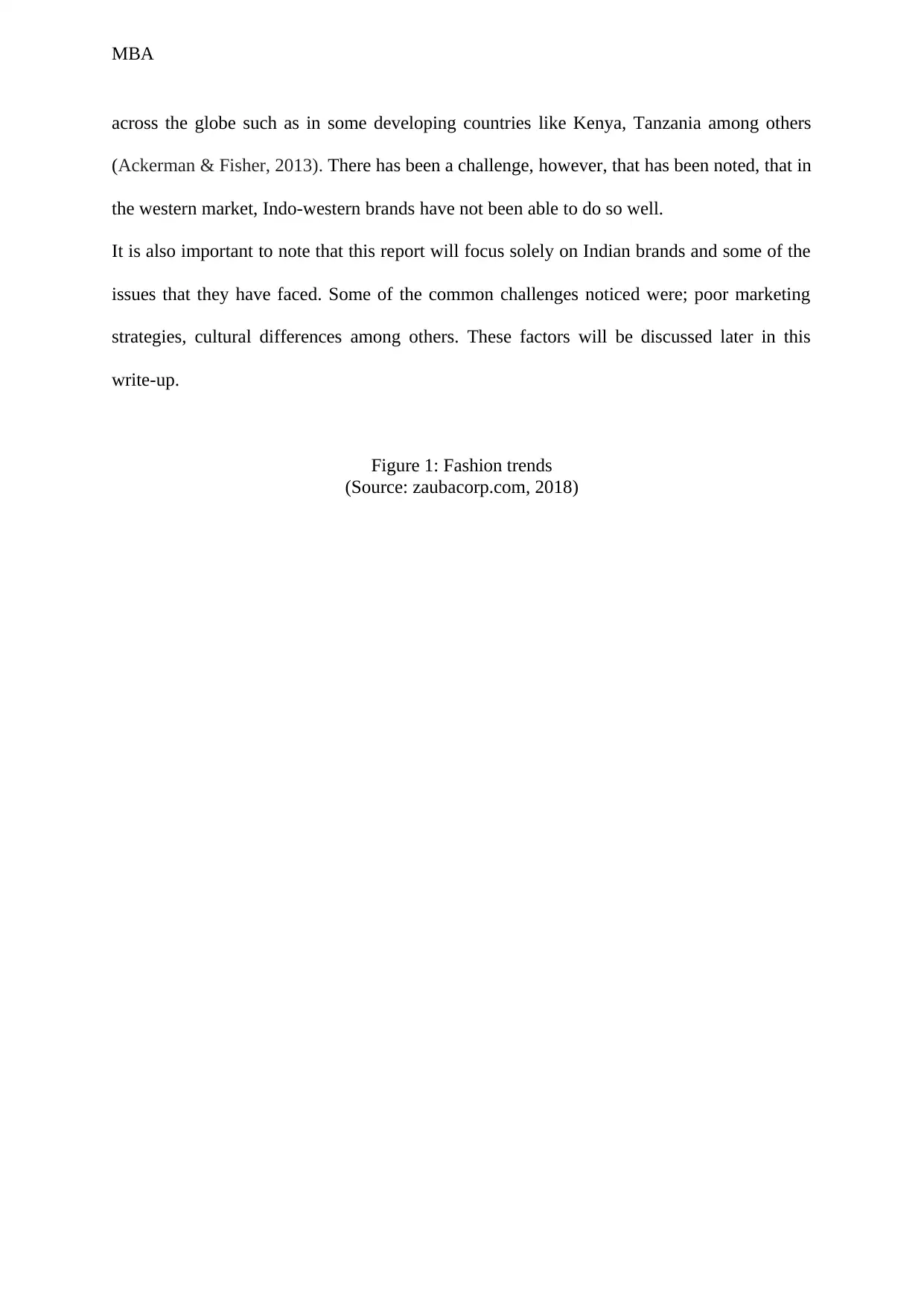
MBA
across the globe such as in some developing countries like Kenya, Tanzania among others
(Ackerman & Fisher, 2013). There has been a challenge, however, that has been noted, that in
the western market, Indo-western brands have not been able to do so well.
It is also important to note that this report will focus solely on Indian brands and some of the
issues that they have faced. Some of the common challenges noticed were; poor marketing
strategies, cultural differences among others. These factors will be discussed later in this
write-up.
Figure 1: Fashion trends
(Source: zaubacorp.com, 2018)
across the globe such as in some developing countries like Kenya, Tanzania among others
(Ackerman & Fisher, 2013). There has been a challenge, however, that has been noted, that in
the western market, Indo-western brands have not been able to do so well.
It is also important to note that this report will focus solely on Indian brands and some of the
issues that they have faced. Some of the common challenges noticed were; poor marketing
strategies, cultural differences among others. These factors will be discussed later in this
write-up.
Figure 1: Fashion trends
(Source: zaubacorp.com, 2018)
Paraphrase This Document
Need a fresh take? Get an instant paraphrase of this document with our AI Paraphraser
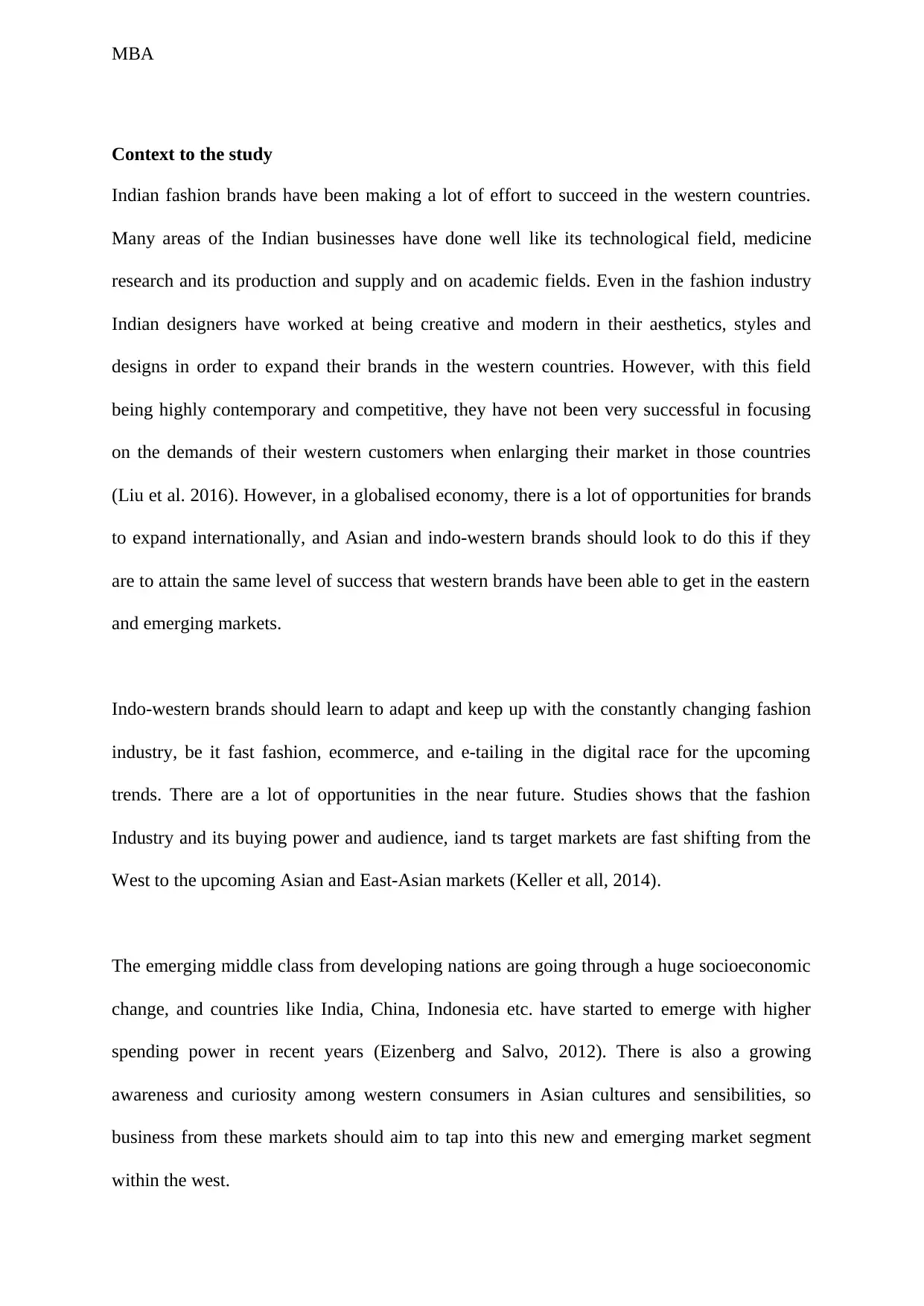
MBA
Context to the study
Indian fashion brands have been making a lot of effort to succeed in the western countries.
Many areas of the Indian businesses have done well like its technological field, medicine
research and its production and supply and on academic fields. Even in the fashion industry
Indian designers have worked at being creative and modern in their aesthetics, styles and
designs in order to expand their brands in the western countries. However, with this field
being highly contemporary and competitive, they have not been very successful in focusing
on the demands of their western customers when enlarging their market in those countries
(Liu et al. 2016). However, in a globalised economy, there is a lot of opportunities for brands
to expand internationally, and Asian and indo-western brands should look to do this if they
are to attain the same level of success that western brands have been able to get in the eastern
and emerging markets.
Indo-western brands should learn to adapt and keep up with the constantly changing fashion
industry, be it fast fashion, ecommerce, and e-tailing in the digital race for the upcoming
trends. There are a lot of opportunities in the near future. Studies shows that the fashion
Industry and its buying power and audience, iand ts target markets are fast shifting from the
West to the upcoming Asian and East-Asian markets (Keller et all, 2014).
The emerging middle class from developing nations are going through a huge socioeconomic
change, and countries like India, China, Indonesia etc. have started to emerge with higher
spending power in recent years (Eizenberg and Salvo, 2012). There is also a growing
awareness and curiosity among western consumers in Asian cultures and sensibilities, so
business from these markets should aim to tap into this new and emerging market segment
within the west.
Context to the study
Indian fashion brands have been making a lot of effort to succeed in the western countries.
Many areas of the Indian businesses have done well like its technological field, medicine
research and its production and supply and on academic fields. Even in the fashion industry
Indian designers have worked at being creative and modern in their aesthetics, styles and
designs in order to expand their brands in the western countries. However, with this field
being highly contemporary and competitive, they have not been very successful in focusing
on the demands of their western customers when enlarging their market in those countries
(Liu et al. 2016). However, in a globalised economy, there is a lot of opportunities for brands
to expand internationally, and Asian and indo-western brands should look to do this if they
are to attain the same level of success that western brands have been able to get in the eastern
and emerging markets.
Indo-western brands should learn to adapt and keep up with the constantly changing fashion
industry, be it fast fashion, ecommerce, and e-tailing in the digital race for the upcoming
trends. There are a lot of opportunities in the near future. Studies shows that the fashion
Industry and its buying power and audience, iand ts target markets are fast shifting from the
West to the upcoming Asian and East-Asian markets (Keller et all, 2014).
The emerging middle class from developing nations are going through a huge socioeconomic
change, and countries like India, China, Indonesia etc. have started to emerge with higher
spending power in recent years (Eizenberg and Salvo, 2012). There is also a growing
awareness and curiosity among western consumers in Asian cultures and sensibilities, so
business from these markets should aim to tap into this new and emerging market segment
within the west.
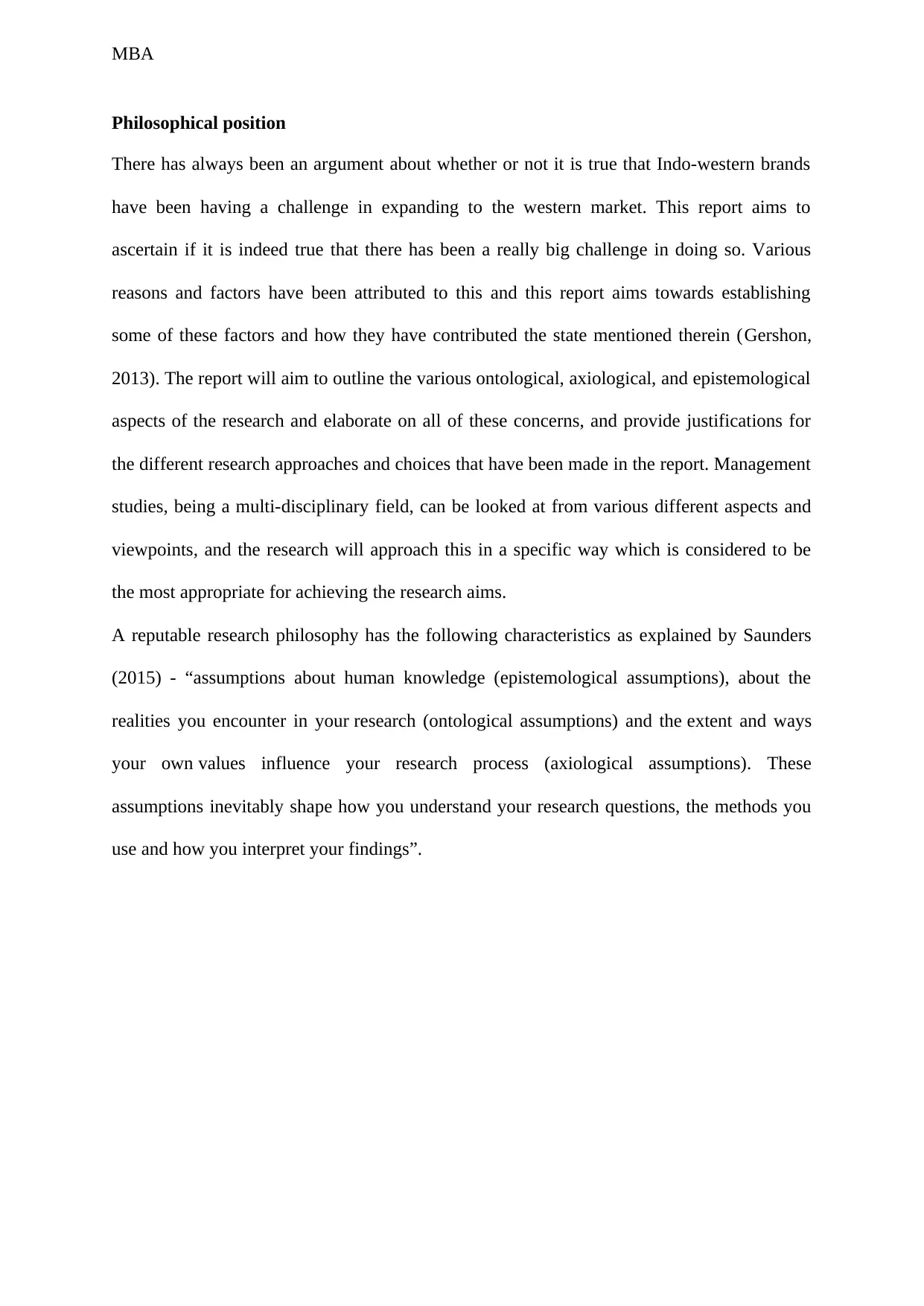
MBA
Philosophical position
There has always been an argument about whether or not it is true that Indo-western brands
have been having a challenge in expanding to the western market. This report aims to
ascertain if it is indeed true that there has been a really big challenge in doing so. Various
reasons and factors have been attributed to this and this report aims towards establishing
some of these factors and how they have contributed the state mentioned therein (Gershon,
2013). The report will aim to outline the various ontological, axiological, and epistemological
aspects of the research and elaborate on all of these concerns, and provide justifications for
the different research approaches and choices that have been made in the report. Management
studies, being a multi-disciplinary field, can be looked at from various different aspects and
viewpoints, and the research will approach this in a specific way which is considered to be
the most appropriate for achieving the research aims.
A reputable research philosophy has the following characteristics as explained by Saunders
(2015) - “assumptions about human knowledge (epistemological assumptions), about the
realities you encounter in your research (ontological assumptions) and the extent and ways
your own values influence your research process (axiological assumptions). These
assumptions inevitably shape how you understand your research questions, the methods you
use and how you interpret your findings”.
Philosophical position
There has always been an argument about whether or not it is true that Indo-western brands
have been having a challenge in expanding to the western market. This report aims to
ascertain if it is indeed true that there has been a really big challenge in doing so. Various
reasons and factors have been attributed to this and this report aims towards establishing
some of these factors and how they have contributed the state mentioned therein (Gershon,
2013). The report will aim to outline the various ontological, axiological, and epistemological
aspects of the research and elaborate on all of these concerns, and provide justifications for
the different research approaches and choices that have been made in the report. Management
studies, being a multi-disciplinary field, can be looked at from various different aspects and
viewpoints, and the research will approach this in a specific way which is considered to be
the most appropriate for achieving the research aims.
A reputable research philosophy has the following characteristics as explained by Saunders
(2015) - “assumptions about human knowledge (epistemological assumptions), about the
realities you encounter in your research (ontological assumptions) and the extent and ways
your own values influence your research process (axiological assumptions). These
assumptions inevitably shape how you understand your research questions, the methods you
use and how you interpret your findings”.
⊘ This is a preview!⊘
Do you want full access?
Subscribe today to unlock all pages.

Trusted by 1+ million students worldwide
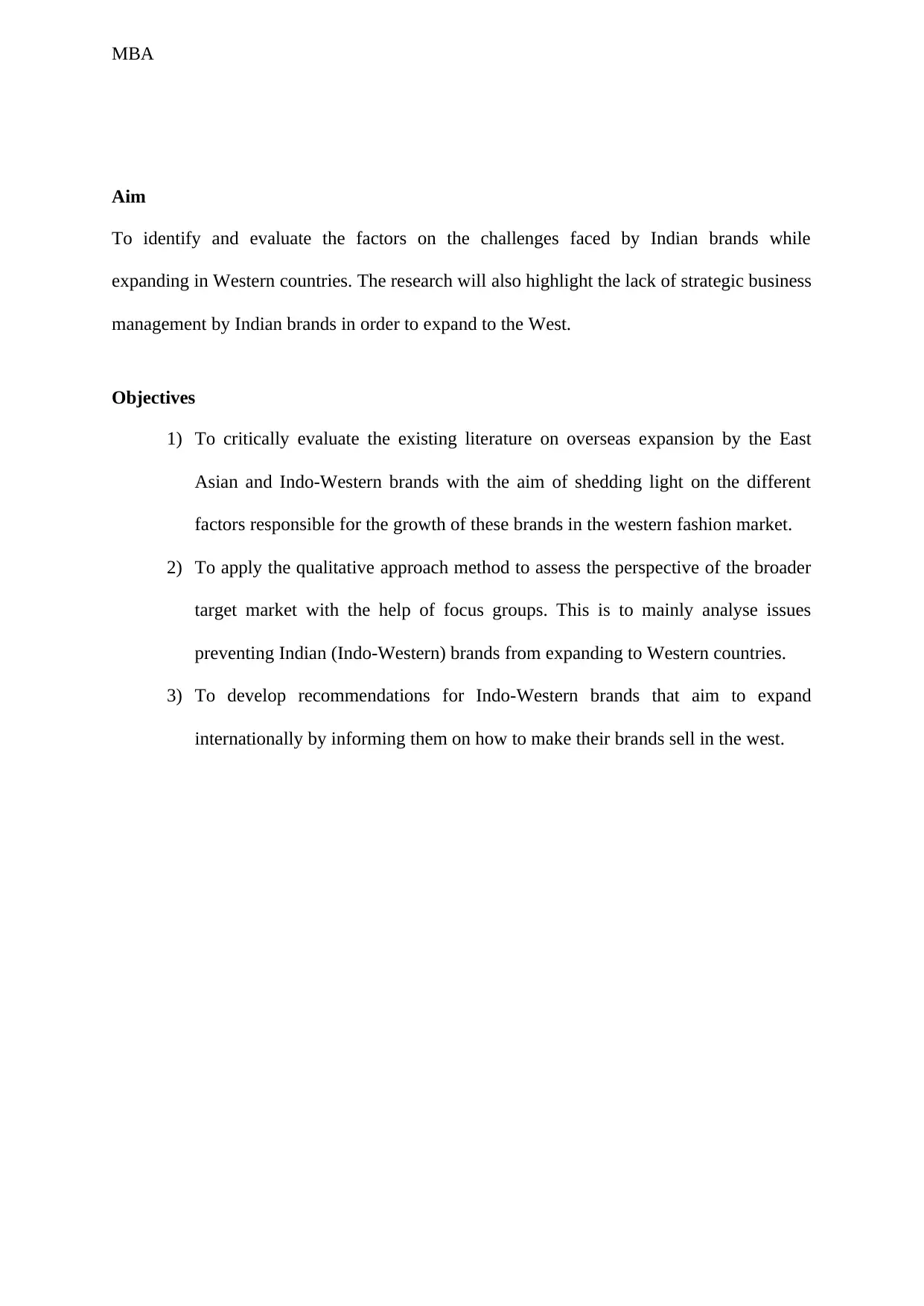
MBA
Aim
To identify and evaluate the factors on the challenges faced by Indian brands while
expanding in Western countries. The research will also highlight the lack of strategic business
management by Indian brands in order to expand to the West.
Objectives
1) To critically evaluate the existing literature on overseas expansion by the East
Asian and Indo-Western brands with the aim of shedding light on the different
factors responsible for the growth of these brands in the western fashion market.
2) To apply the qualitative approach method to assess the perspective of the broader
target market with the help of focus groups. This is to mainly analyse issues
preventing Indian (Indo-Western) brands from expanding to Western countries.
3) To develop recommendations for Indo-Western brands that aim to expand
internationally by informing them on how to make their brands sell in the west.
Aim
To identify and evaluate the factors on the challenges faced by Indian brands while
expanding in Western countries. The research will also highlight the lack of strategic business
management by Indian brands in order to expand to the West.
Objectives
1) To critically evaluate the existing literature on overseas expansion by the East
Asian and Indo-Western brands with the aim of shedding light on the different
factors responsible for the growth of these brands in the western fashion market.
2) To apply the qualitative approach method to assess the perspective of the broader
target market with the help of focus groups. This is to mainly analyse issues
preventing Indian (Indo-Western) brands from expanding to Western countries.
3) To develop recommendations for Indo-Western brands that aim to expand
internationally by informing them on how to make their brands sell in the west.
Paraphrase This Document
Need a fresh take? Get an instant paraphrase of this document with our AI Paraphraser
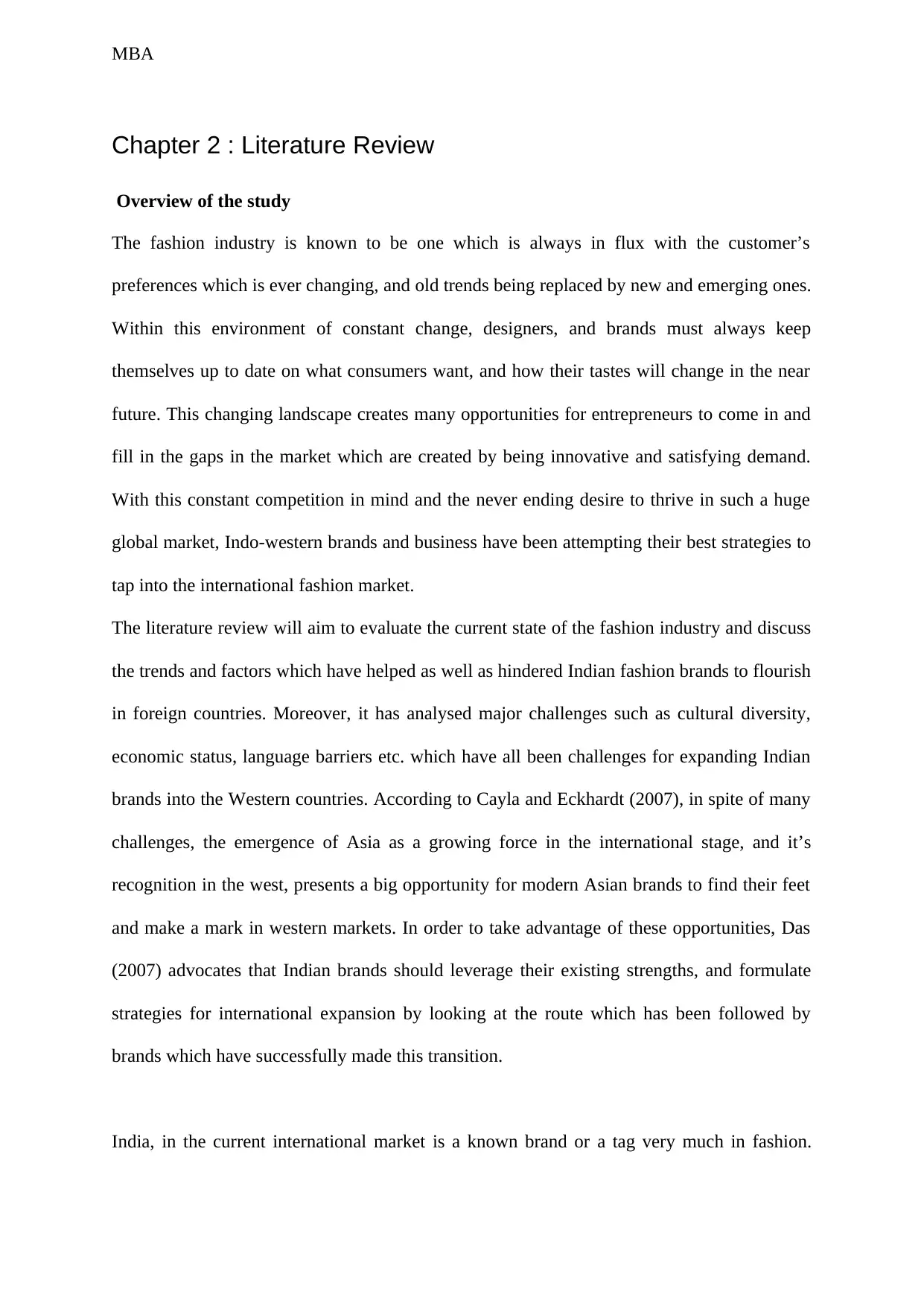
MBA
Chapter 2 : Literature Review
Overview of the study
The fashion industry is known to be one which is always in flux with the customer’s
preferences which is ever changing, and old trends being replaced by new and emerging ones.
Within this environment of constant change, designers, and brands must always keep
themselves up to date on what consumers want, and how their tastes will change in the near
future. This changing landscape creates many opportunities for entrepreneurs to come in and
fill in the gaps in the market which are created by being innovative and satisfying demand.
With this constant competition in mind and the never ending desire to thrive in such a huge
global market, Indo-western brands and business have been attempting their best strategies to
tap into the international fashion market.
The literature review will aim to evaluate the current state of the fashion industry and discuss
the trends and factors which have helped as well as hindered Indian fashion brands to flourish
in foreign countries. Moreover, it has analysed major challenges such as cultural diversity,
economic status, language barriers etc. which have all been challenges for expanding Indian
brands into the Western countries. According to Cayla and Eckhardt (2007), in spite of many
challenges, the emergence of Asia as a growing force in the international stage, and it’s
recognition in the west, presents a big opportunity for modern Asian brands to find their feet
and make a mark in western markets. In order to take advantage of these opportunities, Das
(2007) advocates that Indian brands should leverage their existing strengths, and formulate
strategies for international expansion by looking at the route which has been followed by
brands which have successfully made this transition.
India, in the current international market is a known brand or a tag very much in fashion.
Chapter 2 : Literature Review
Overview of the study
The fashion industry is known to be one which is always in flux with the customer’s
preferences which is ever changing, and old trends being replaced by new and emerging ones.
Within this environment of constant change, designers, and brands must always keep
themselves up to date on what consumers want, and how their tastes will change in the near
future. This changing landscape creates many opportunities for entrepreneurs to come in and
fill in the gaps in the market which are created by being innovative and satisfying demand.
With this constant competition in mind and the never ending desire to thrive in such a huge
global market, Indo-western brands and business have been attempting their best strategies to
tap into the international fashion market.
The literature review will aim to evaluate the current state of the fashion industry and discuss
the trends and factors which have helped as well as hindered Indian fashion brands to flourish
in foreign countries. Moreover, it has analysed major challenges such as cultural diversity,
economic status, language barriers etc. which have all been challenges for expanding Indian
brands into the Western countries. According to Cayla and Eckhardt (2007), in spite of many
challenges, the emergence of Asia as a growing force in the international stage, and it’s
recognition in the west, presents a big opportunity for modern Asian brands to find their feet
and make a mark in western markets. In order to take advantage of these opportunities, Das
(2007) advocates that Indian brands should leverage their existing strengths, and formulate
strategies for international expansion by looking at the route which has been followed by
brands which have successfully made this transition.
India, in the current international market is a known brand or a tag very much in fashion.

MBA
Like everything else in the current world stage Indian culture has also become a saleable
commodity (Sarulatha, and Sasirekha, 2017). However, in terms of the global market , when
it comes to becoming a staple for the average fashion junkie, India has still not produced
brands or products of much significance. Being a global manufacturing hub, India has always
been production oriented. They are still a developing nation and do not have the sufficient
resources to create a sustainable fashion industry. Because of this, its influence in the global
fashion industry is also limited. Their factories are mostly used for producing outsourced
goods for international brands like Levi’s and Nike. The products of these brands are too
expensive for the Indian middle and lower classes, and most of their own markets are flooded
with Chinese mass produced goods.
The conceptual framework below will explain and help the reader understand the reasons for,
and importance of this research, and how it intends to find gaps and opportunities, and bridge
out the differences and create platforms, literature support and common grounds for Indo-
Western brands’ expansion internationally to the right international markets.
According to Hellman (2017), Indians consider both Indian as well as western dresses/outfits
on different occasions. Due to this familiarity with both types of fashion and apparel, fusion
wear has modernized the Indian fashion industry to a high extent. It is observed that the top-
notch brands focus on different elements in their collection. The country still has a long way
to go if we consider the market potential for fusion wear in India in the near future. However,
in contrast to this, BOF (2018) stated that the ethnic Indian wear genre is used in current
trends. It plans to lead the way for women’s wear in India. Indo-western brands have been
tracking the dynamics of ethnic fashion in malls, as well as in standalone stores recently.
Among the current generation, it is seen that fashion is starting to become a major concern
for Indian individuals. Further, fashion is determined by the western dresses via social media
Like everything else in the current world stage Indian culture has also become a saleable
commodity (Sarulatha, and Sasirekha, 2017). However, in terms of the global market , when
it comes to becoming a staple for the average fashion junkie, India has still not produced
brands or products of much significance. Being a global manufacturing hub, India has always
been production oriented. They are still a developing nation and do not have the sufficient
resources to create a sustainable fashion industry. Because of this, its influence in the global
fashion industry is also limited. Their factories are mostly used for producing outsourced
goods for international brands like Levi’s and Nike. The products of these brands are too
expensive for the Indian middle and lower classes, and most of their own markets are flooded
with Chinese mass produced goods.
The conceptual framework below will explain and help the reader understand the reasons for,
and importance of this research, and how it intends to find gaps and opportunities, and bridge
out the differences and create platforms, literature support and common grounds for Indo-
Western brands’ expansion internationally to the right international markets.
According to Hellman (2017), Indians consider both Indian as well as western dresses/outfits
on different occasions. Due to this familiarity with both types of fashion and apparel, fusion
wear has modernized the Indian fashion industry to a high extent. It is observed that the top-
notch brands focus on different elements in their collection. The country still has a long way
to go if we consider the market potential for fusion wear in India in the near future. However,
in contrast to this, BOF (2018) stated that the ethnic Indian wear genre is used in current
trends. It plans to lead the way for women’s wear in India. Indo-western brands have been
tracking the dynamics of ethnic fashion in malls, as well as in standalone stores recently.
Among the current generation, it is seen that fashion is starting to become a major concern
for Indian individuals. Further, fashion is determined by the western dresses via social media
⊘ This is a preview!⊘
Do you want full access?
Subscribe today to unlock all pages.

Trusted by 1+ million students worldwide

MBA
influences and cross-cultural influences. It has also been analysed that India has begun to
follow and be influenced by Indo-western culture wherein they consider traditional as well as
western ensembles in their culture.
Kazi (2018) states that the expansion of Indo-western wear is proving to be a boon for ethnic
fashion in India since,customers are willing to consume and experiment products ,and that it
could lead to great demand for Indo-Western brands. This is a key reason that ethnic brands
are generating a wide range of alternatives that a customer can explore for attending different
functions.
2015).
influences and cross-cultural influences. It has also been analysed that India has begun to
follow and be influenced by Indo-western culture wherein they consider traditional as well as
western ensembles in their culture.
Kazi (2018) states that the expansion of Indo-western wear is proving to be a boon for ethnic
fashion in India since,customers are willing to consume and experiment products ,and that it
could lead to great demand for Indo-Western brands. This is a key reason that ethnic brands
are generating a wide range of alternatives that a customer can explore for attending different
functions.
2015).
Paraphrase This Document
Need a fresh take? Get an instant paraphrase of this document with our AI Paraphraser
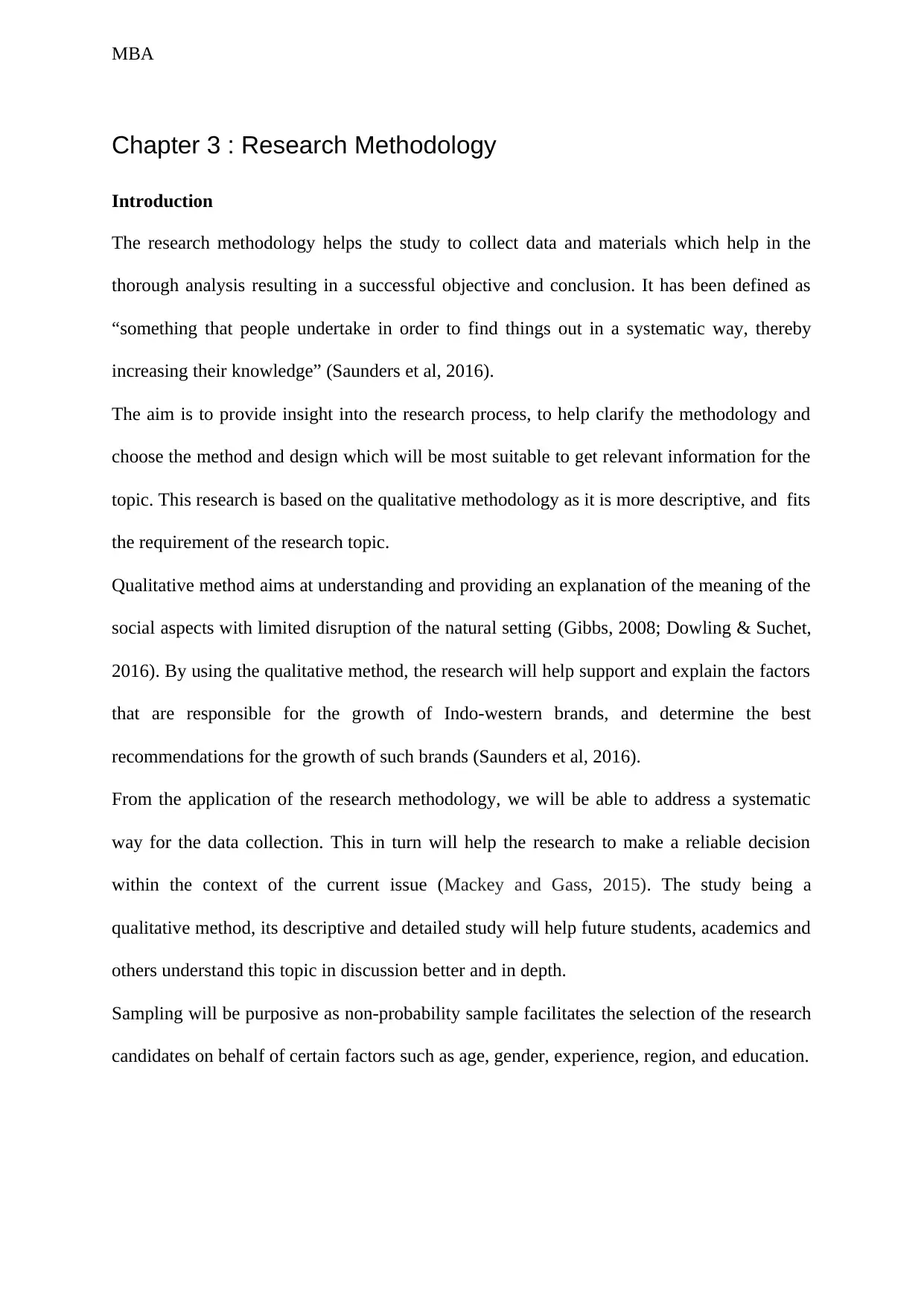
MBA
Chapter 3 : Research Methodology
Introduction
The research methodology helps the study to collect data and materials which help in the
thorough analysis resulting in a successful objective and conclusion. It has been defined as
“something that people undertake in order to find things out in a systematic way, thereby
increasing their knowledge” (Saunders et al, 2016).
The aim is to provide insight into the research process, to help clarify the methodology and
choose the method and design which will be most suitable to get relevant information for the
topic. This research is based on the qualitative methodology as it is more descriptive, and fits
the requirement of the research topic.
Qualitative method aims at understanding and providing an explanation of the meaning of the
social aspects with limited disruption of the natural setting (Gibbs, 2008; Dowling & Suchet,
2016). By using the qualitative method, the research will help support and explain the factors
that are responsible for the growth of Indo-western brands, and determine the best
recommendations for the growth of such brands (Saunders et al, 2016).
From the application of the research methodology, we will be able to address a systematic
way for the data collection. This in turn will help the research to make a reliable decision
within the context of the current issue (Mackey and Gass, 2015). The study being a
qualitative method, its descriptive and detailed study will help future students, academics and
others understand this topic in discussion better and in depth.
Sampling will be purposive as non-probability sample facilitates the selection of the research
candidates on behalf of certain factors such as age, gender, experience, region, and education.
Chapter 3 : Research Methodology
Introduction
The research methodology helps the study to collect data and materials which help in the
thorough analysis resulting in a successful objective and conclusion. It has been defined as
“something that people undertake in order to find things out in a systematic way, thereby
increasing their knowledge” (Saunders et al, 2016).
The aim is to provide insight into the research process, to help clarify the methodology and
choose the method and design which will be most suitable to get relevant information for the
topic. This research is based on the qualitative methodology as it is more descriptive, and fits
the requirement of the research topic.
Qualitative method aims at understanding and providing an explanation of the meaning of the
social aspects with limited disruption of the natural setting (Gibbs, 2008; Dowling & Suchet,
2016). By using the qualitative method, the research will help support and explain the factors
that are responsible for the growth of Indo-western brands, and determine the best
recommendations for the growth of such brands (Saunders et al, 2016).
From the application of the research methodology, we will be able to address a systematic
way for the data collection. This in turn will help the research to make a reliable decision
within the context of the current issue (Mackey and Gass, 2015). The study being a
qualitative method, its descriptive and detailed study will help future students, academics and
others understand this topic in discussion better and in depth.
Sampling will be purposive as non-probability sample facilitates the selection of the research
candidates on behalf of certain factors such as age, gender, experience, region, and education.

MBA
A thorough data analysis will be performed with the help of Focus Group Discussion(FGD),
and the focus group primary approach is chosen as this helps get accurate, detailed and valid
results at the given amount of time.
Finally, the validity and reliability of the data will be carried out, and the ethical issues
around the study, and the limitations of the research will also be outlined in the end of this
chapter.
Research Philosophy (Philosophical Position)
According to Houghton, Hunter & Meskell (2012) the research philosophy aims at defining
the basis, description and progress of knowledge under the topic of the study. Research
philosophy aids in assembling the hypothesis and beliefs of the topic to attain a precise
strategy of fact gathering. Houghton, Hunter & Meskell (2012) have identified three different
types of philosophies: positivism, interpretivism and realism research philosophies. Based on
the current research topic this study has chosen to use the interpretivism method.
Interpretivism philosophy focuses on collecting primary and socially composed data that is
significant in assembling accurate, reliable and valid information required for the study
(Corbally, 2014).
In this research, the interpretivism process is used to interpret the elements of the study since
access to reality is usually socially constructed through various ways such as language,
shared meanings, and consciousness. It supports interactive, cooperative participation and
runs the study on valid grounds to help understand and explain the topic, and to understand
the aim of the study in depth. The information that the research acquires from the participants
and study are valid, meaningful and helpful to support the topic. This primary method helps
to support the methodology further qualitatively.
As stated by Nicotera (2017), interpretivism allows the researcher to interpret the factors of
study as per his or her observation and interpretation skills supported by the knowledge. This
A thorough data analysis will be performed with the help of Focus Group Discussion(FGD),
and the focus group primary approach is chosen as this helps get accurate, detailed and valid
results at the given amount of time.
Finally, the validity and reliability of the data will be carried out, and the ethical issues
around the study, and the limitations of the research will also be outlined in the end of this
chapter.
Research Philosophy (Philosophical Position)
According to Houghton, Hunter & Meskell (2012) the research philosophy aims at defining
the basis, description and progress of knowledge under the topic of the study. Research
philosophy aids in assembling the hypothesis and beliefs of the topic to attain a precise
strategy of fact gathering. Houghton, Hunter & Meskell (2012) have identified three different
types of philosophies: positivism, interpretivism and realism research philosophies. Based on
the current research topic this study has chosen to use the interpretivism method.
Interpretivism philosophy focuses on collecting primary and socially composed data that is
significant in assembling accurate, reliable and valid information required for the study
(Corbally, 2014).
In this research, the interpretivism process is used to interpret the elements of the study since
access to reality is usually socially constructed through various ways such as language,
shared meanings, and consciousness. It supports interactive, cooperative participation and
runs the study on valid grounds to help understand and explain the topic, and to understand
the aim of the study in depth. The information that the research acquires from the participants
and study are valid, meaningful and helpful to support the topic. This primary method helps
to support the methodology further qualitatively.
As stated by Nicotera (2017), interpretivism allows the researcher to interpret the factors of
study as per his or her observation and interpretation skills supported by the knowledge. This
⊘ This is a preview!⊘
Do you want full access?
Subscribe today to unlock all pages.

Trusted by 1+ million students worldwide
1 out of 31
Related Documents
Your All-in-One AI-Powered Toolkit for Academic Success.
+13062052269
info@desklib.com
Available 24*7 on WhatsApp / Email
![[object Object]](/_next/static/media/star-bottom.7253800d.svg)
Unlock your academic potential
Copyright © 2020–2025 A2Z Services. All Rights Reserved. Developed and managed by ZUCOL.





